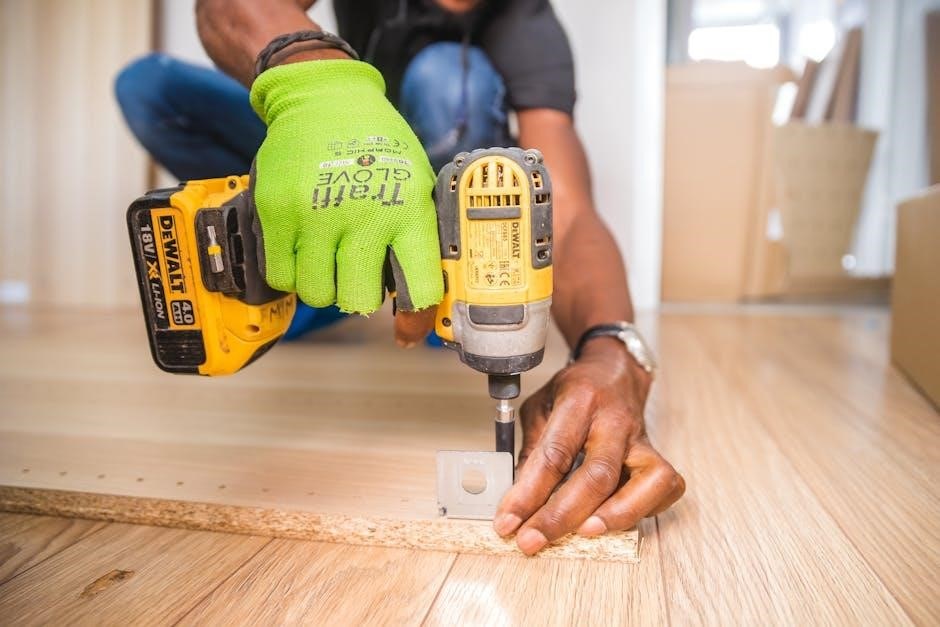
Craftsman Electric Weed Wacker Manual: A Comprehensive Guide
Welcome to your ultimate resource for mastering your Craftsman electric weed wacker! This comprehensive guide is designed to provide you with the necessary insights for safe operation, maintenance tips, and troubleshooting solutions. Explore the intricacies of your tool with us!
Craftsman electric weed wackers offer a convenient and efficient solution for maintaining your lawn and garden. Known for their reliability and ease of use, these tools are designed to tackle overgrown grass, weeds, and other unwanted vegetation with precision. Unlike their gas-powered counterparts, electric weed wackers are lighter, quieter, and require less maintenance, making them a popular choice for homeowners.
Craftsman offers a variety of electric weed wacker models, each with unique features and capabilities. Whether you’re looking for a corded or cordless option, there’s a Craftsman weed wacker to suit your needs. Corded models provide continuous power for larger jobs, while cordless models offer greater freedom of movement and portability.
Understanding the specific features and functions of your Craftsman electric weed wacker is crucial for safe and effective operation. This guide provides a comprehensive overview of Craftsman electric weed wackers, including how to find the correct manual for your model, safety precautions, assembly and setup instructions, operating instructions, maintenance tips, and troubleshooting solutions. Whether you’re a first-time user or an experienced gardener, this guide will help you get the most out of your Craftsman electric weed wacker.
We will also cover battery care and usage for cordless models and warranty information to ensure you are well-informed about your product’s coverage. Finally, we will address common issues and provide practical solutions to keep your weed wacker running smoothly. Let’s dive in and explore the world of Craftsman electric weed wackers!
Finding the Correct Manual for Your Model

Locating the right manual for your Craftsman electric weed wacker is essential for safe and effective operation. The manual contains crucial information about assembly, operation, maintenance, and troubleshooting specific to your model. Without it, you risk using the tool incorrectly or performing maintenance that could damage the unit.
The most reliable way to find your manual is by identifying the model number of your weed wacker. This number is typically located on a sticker or plate affixed to the tool itself, often near the motor or handle. Once you have the model number, you can search for the manual online. Craftsman’s website is an excellent starting point, as it often hosts digital copies of manuals for many of their products.
If you can’t find the manual on the Craftsman website, try searching online using the model number and keywords like “owner’s manual” or “user guide.” Several websites specialize in hosting manuals for various products, including lawn and garden equipment. Be sure to download the manual from a reputable source to avoid malware or incorrect information.
Another option is to contact Craftsman’s customer support directly. They may be able to provide you with a digital copy of the manual or guide you to where you can find it. Remember, having the correct manual is vital for ensuring you operate and maintain your Craftsman electric weed wacker safely and effectively.
Safety Precautions and Guidelines
Prioritizing safety is paramount when operating any power tool, and the Craftsman electric weed wacker is no exception. Before each use, thoroughly inspect the weed wacker for any signs of damage or wear. Ensure all guards and safety features are properly installed and functioning correctly. Never operate the tool if parts are missing or damaged.
Always wear appropriate personal protective equipment (PPE), including safety glasses or goggles, to protect your eyes from flying debris. Long pants and closed-toe shoes are also essential to shield your legs and feet. Consider wearing work gloves to improve grip and protect your hands from blisters or cuts.
Be mindful of your surroundings. Clear the area of any obstacles, such as rocks, branches, or toys, that could become projectiles. Keep children and pets a safe distance away from the work area. Never use the weed wacker near water or in wet conditions, as this poses a risk of electric shock.
When operating the weed wacker, maintain a firm grip and a stable stance. Avoid overreaching or working in awkward positions. Take frequent breaks to prevent fatigue, which can lead to accidents. Always disconnect the power cord before performing any maintenance or adjustments. Store the weed wacker in a safe, dry place out of reach of children.
Assembly and Initial Setup

Before you can unleash the power of your Craftsman electric weed wacker, a proper assembly and initial setup are essential. Begin by carefully unpacking all components and comparing them to the parts list in your manual. Ensure you have every piece necessary for a smooth operation. If anything is missing or damaged, contact Craftsman customer support immediately.
Next, follow the step-by-step instructions in your manual to assemble the weed wacker. Typically, this involves attaching the handle, guard, and possibly the cutting head. Make sure all connections are secure and tightened properly. Loose connections can lead to malfunctions and potential hazards during use.
Once assembled, familiarize yourself with the various controls and features of your weed wacker. Locate the power switch, safety lock, and any adjustable settings. Consult your manual for detailed explanations of each function. Before plugging in or inserting the battery, double-check all connections and ensure the cutting head is free from obstructions.
Finally, perform a test run in a safe, open area. Observe the weed wacker’s performance, listening for any unusual noises or vibrations. If everything seems normal, you’re ready to tackle your lawn care tasks with confidence. Remember to always consult your manual for specific instructions and safety precautions related to your model.
Operating Instructions
Operating your Craftsman electric weed wacker effectively requires understanding its controls and employing safe practices. Before starting, always wear appropriate safety gear, including eye protection and closed-toe shoes. Clear the area of any obstacles, such as rocks or toys, that could become projectiles.
To begin trimming, hold the weed wacker firmly with both hands, maintaining a balanced stance. Position the cutting head at the desired height and angle, ensuring it’s clear of your feet and any nearby objects. Engage the power switch and safety lock, following the specific instructions in your manual.
Move the weed wacker in a smooth, sweeping motion, allowing the cutting line to trim the grass or weeds. Avoid forcing the tool or overloading the motor. If the cutting line becomes tangled or worn, stop the weed wacker and replace it according to the manual’s instructions.
For edging, some Craftsman models feature a rotating head or adjustable handle. Consult your manual for instructions on how to convert your weed wacker for edging tasks. When edging, maintain a steady pace and avoid applying excessive pressure.
Always turn off and unplug the weed wacker before making any adjustments or clearing debris. Store the tool in a dry, safe place, away from children and pets. Regularly review the operating instructions in your manual to ensure you’re using your Craftsman electric weed wacker safely and efficiently.
Maintenance and Troubleshooting
Proper maintenance is crucial for extending the life of your Craftsman electric weed wacker and ensuring optimal performance. Before performing any maintenance, always disconnect the power cord to prevent accidental starts.
Regularly inspect the cutting head for wear and tear. Replace the cutting line when it becomes frayed or short. Clean the cutting head and surrounding area to remove debris that can hinder performance. Check the air vents for obstructions and clear them as needed to prevent overheating.
If your weed wacker isn’t starting, check the power cord and outlet to ensure they’re functioning correctly. If the motor is running but the cutting head isn’t spinning, inspect the drive shaft or belt for damage or wear. Replace any worn or damaged parts according to the manual’s instructions.

If you experience excessive vibration or noise, stop the weed wacker and inspect the cutting head and motor for loose parts or damage. Tighten any loose screws or bolts and replace any damaged components;
For more complex issues, consult the troubleshooting section of your Craftsman electric weed wacker manual. If you’re unable to resolve the problem yourself, contact a qualified repair technician for assistance. Regular maintenance and prompt troubleshooting will keep your weed wacker running smoothly for years to come.
Cordless Models: Battery Care and Usage
Craftsman cordless electric weed wackers offer unparalleled convenience, but proper battery care is essential for maximizing their lifespan and performance. Always use the charger specifically designed for your model’s battery to avoid damage. Before first use, fully charge the battery according to the manufacturer’s instructions. Avoid overcharging, as this can shorten the battery’s life.
When not in use, store the battery in a cool, dry place away from direct sunlight and extreme temperatures. Do not store a fully discharged battery for extended periods, as this can lead to irreversible damage. It’s best to store it with a partial charge.
During operation, avoid completely draining the battery. Recharge it when the power starts to diminish to maintain its health. If you notice a significant decrease in battery runtime, it may be time to replace the battery.
Clean the battery contacts regularly with a dry cloth to ensure good connectivity. Inspect the battery pack for any signs of damage, such as cracks or leaks. If you notice any damage, discontinue use and replace the battery.
Always follow the safety precautions outlined in your Craftsman electric weed wacker manual when handling and charging batteries. Proper care and usage will ensure your cordless weed wacker is always ready when you need it.
Understanding Warranty Information
Your Craftsman electric weed wacker comes with a warranty designed to protect you from defects in material or workmanship. To fully benefit from this coverage, it’s crucial to understand the terms and conditions outlined in your owner’s manual.
Typically, Craftsman offers a limited warranty that covers the tool for a specific period from the date of purchase. This warranty usually covers non-commercial or household usage, so commercial users should be aware of potentially shorter warranty periods.
Keep your purchase receipt or proof of purchase in a safe place, as it will be required to validate any warranty claims. The warranty typically covers repairs or replacements of defective parts, but it may not cover damages caused by misuse, neglect, or unauthorized modifications.
Before attempting any repairs yourself, review the warranty information to ensure you don’t void the coverage. Contact Craftsman’s customer service or an authorized service center for warranty-related issues.
Familiarize yourself with the specific exclusions of the warranty, such as normal wear and tear, consumable parts, or damage resulting from improper maintenance. By understanding the warranty’s scope, you can ensure you receive the support you’re entitled to while maintaining your tool in optimal condition.
Common Issues and Solutions
Even with proper care, you might encounter some common issues with your Craftsman electric weed wacker. Understanding these problems and their solutions can save you time and money on repairs.
One frequent issue is the trimmer line breaking too often. This can be due to using the wrong type or size of line, or trimming against hard surfaces. Ensure you’re using the recommended line and avoid hitting concrete or rocks.
Another problem is the trimmer not starting. Check the power cord for damage, and ensure the outlet is working. For cordless models, make sure the battery is fully charged and properly connected.
If the trimmer head isn’t advancing the line, it could be due to a tangled spool or a worn-out line feed mechanism. Clean the spool and replace the line if necessary. If the problem persists, the line feed mechanism may need replacement.

Overheating can also be an issue, especially during prolonged use. Allow the trimmer to cool down periodically to prevent damage to the motor.
Finally, if you notice unusual noises or vibrations, inspect the trimmer head for damage or debris. Remove any obstructions and tighten any loose parts. By addressing these common issues promptly, you can keep your weed wacker running smoothly.




